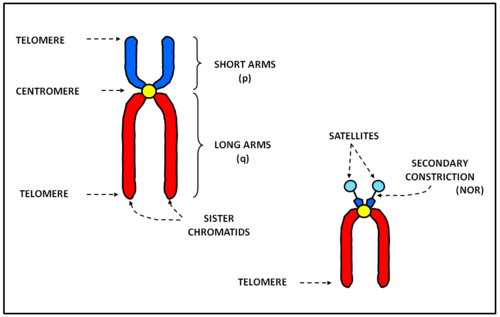Structure and types of the eukaryotic chromosomes
From WikiLectures
Chromosome = DNA molecule + proteins; in interphase decondensed in tiny fibers, during mitosis condensed in visible particles (methaphase chromosomes in light microscope)
- Chromosome condensation (multilevel spiralisation)
- interaction with different types of proteins
- shortening of chromosome 50 000x in mitosis
- nucleosome fiber („beads on a string“, 11 nm in diameter) - nucleosome core of 8 histone molecules (2xH2A, 2xH2B, 2xH3, 2xH4), DNA turns around in one and ¾ loops and is fixed by histone H1
- solenoid – 6 nucleosomes per one turn; solenoid loops form chromatine fiber (diameter 30 nm)
- chromatin fiber loops are attached to the protein scaffold (300 nm in diameter) and the whole structure is again spiralised (700 nm in diameter) with different density along the chromosome
- metaphase chromosome consists of two sister chromatids (total diameter 1400 nm)
- Structure of eukaryotic chromosomes
- Chromosome types
- metacentric (mediocentric) – centromere in the middle of the chromosome lenght
- submetacentric – centromere divides chromosome into short (p) and long arms (q)
- acrocentric – very short p-arms, secondary constriction (NOR - nucleolar organizing region with many copies of rRNA genes) and terminal structure of satellites
- telocentric – only centromere and long arms; not in human beings, typical for example for mice and rats
- holocentric – multiple sites of attachment to the spindle along the chromosome; in insects or worms.


